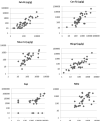A comparison of subject room dust with home vacuum dust for evaluation of dust-borne aeroallergens
- PMID: 23622010
- PMCID: PMC3870589
- DOI: 10.1016/j.anai.2013.02.010
A comparison of subject room dust with home vacuum dust for evaluation of dust-borne aeroallergens
Abstract
Background: Assessment of indoor allergen is valuable in exposure research and evaluation of allergic individuals. Collection methods range from grab vacuum samples to filtration devices located in the breathing range of an individual. For practical purposes, many research studies use analysis of collected house dust to evaluate allergen reservoirs.
Objective: To test the hypothesis that house dust collected from the family vacuum is equivalent to house dust collected by a technician following standard protocol.
Methods: Homes from a healthy homes demonstration project (n = 41) were sampled using a specific Department of Housing and Urban Development-suggested protocol in the bedroom of the child with asthma and a simple grab procedure from the family vacuum. Samples were evaluated for the presence of 5 allergens, Bla g2, Can f1, Der f1, and Der p1 combined as total mite, Fel d1, and Mus m1. Samples were also evaluated for total antigenic protein from 4 fungal taxa, including Alternaria, Aspergillus, Cladosporium, and Penicillium.
Results: All of the allergens and antigens tested showed good correlation between the 2 collection methods. Fungal antigens ranged up to 92,651 nanograms per gram of dust for Aspergillus, and allergens ranged up to 17,928 nanograms per gram of dust for Can f1. The best correlation was for Cladosporium (r = 0.91), and the weakest was for dust mite (r = 0.34).
Conclusion: Allergens and antigens tested from samples collected by protocol and by grab sampling from the home vacuum were highly positively correlated. Grab samples taken from the family vacuum may be a good surrogate for evaluating home allergen exposure.
Copyright © 2013 American College of Allergy, Asthma & Immunology. Published by Elsevier Inc. All rights reserved.
Figures


Similar articles
-
Use of an electrostatic dust cloth for self-administered home allergen collection.Twin Res Hum Genet. 2008 Apr;11(2):150-5. doi: 10.1375/twin.11.2.150. Twin Res Hum Genet. 2008. PMID: 18361715
-
Efficacy of an in-home test kit in reducing dust mite allergen levels: results of a randomized controlled pilot study.J Asthma. 2016;53(2):133-8. doi: 10.3109/02770903.2015.1072721. Epub 2015 Aug 24. J Asthma. 2016. PMID: 26308287 Free PMC article. Clinical Trial.
-
Repeated measurements of mite and pet allergen levels in house dust over a time period of 8 years.Clin Exp Allergy. 2006 Dec;36(12):1525-31. doi: 10.1111/j.1365-2222.2006.02603.x. Clin Exp Allergy. 2006. PMID: 17177675
-
Arthropod allergens in urban homes.Arh Hig Rada Toksikol. 2012;63 Suppl 1:47-56. doi: 10.2478/10004-1254-63-2012-2125. Arh Hig Rada Toksikol. 2012. PMID: 22548852 Review.
-
Quantification of house dust mite allergens in ambient air.Rev Environ Health. 2001 Jan-Mar;16(1):65-80. doi: 10.1515/reveh.2001.16.1.65. Rev Environ Health. 2001. PMID: 11354542 Review.
Cited by
-
Ensuring healthy American Indian generations for tomorrow through safe and healthy indoor environments.Int J Environ Res Public Health. 2015 Mar 4;12(3):2810-22. doi: 10.3390/ijerph120302810. Int J Environ Res Public Health. 2015. PMID: 25749318 Free PMC article.
-
Human β-defensin HBD3 binds to immobilized Bla g2 from the German cockroach (Blattella germanica).Peptides. 2014 Mar;53:265-9. doi: 10.1016/j.peptides.2014.01.017. Epub 2014 Feb 2. Peptides. 2014. PMID: 24495736 Free PMC article.
-
Ara h2 levels in dust from homes of individuals with peanut allergy and individuals with peanut tolerance.Allergy Asthma Proc. 2017 May 1;38(3):192-196. doi: 10.2500/aap.2017.38.4049. Allergy Asthma Proc. 2017. PMID: 28441989 Free PMC article.
-
Comparison of allergens collected from furnace filters and vacuum floor dust.Ann Allergy Asthma Immunol. 2017 Jan;118(1):108-109. doi: 10.1016/j.anai.2016.10.001. Epub 2016 Nov 7. Ann Allergy Asthma Immunol. 2017. PMID: 27839669 Free PMC article. No abstract available.
-
Sampling Devices for Indoor Allergen Exposure: Pros and Cons.Curr Allergy Asthma Rep. 2019 Feb 12;19(1):9. doi: 10.1007/s11882-019-0833-y. Curr Allergy Asthma Rep. 2019. PMID: 30747291 Free PMC article. Review.
References
-
- Tovey E, Ferro A. Time for new methods for avoidance of house dust mite and other allergens. Current Allergy and Asthma Reports. 2012;12:465–477. - PubMed
-
- Tovey ER, Chapman MD, Wells CW, Platts-Mills TA. The distribution of dust mite allergen in the houses of patients with asthma. Am Rev Respir Dis. 1981;124:630–635. - PubMed
-
- Mosbech H, Lind P. Collection of house dust for analysis of mite allergens:allergen-reducing effect of a self-administered procedure. Allergy. 1986;41:373–378. - PubMed
-
- Mansour M, Lanphear BP, Hornung R, et al. A side-by-side comparison of sampling methods for settled, indoor allergens. Environ Res. 2001;87:37–46. - PubMed
-
- Kattan M, Stearns SC, Crain EF, et al. Cost-effectiveness of a home-based environmental intervention for inner-city children with asthma. J Allergy Clin Immunol. 2005;116:1058–1063. - PubMed
Publication types
MeSH terms
Substances
Grants and funding
LinkOut - more resources
Full Text Sources
Other Literature Sources
Medical

